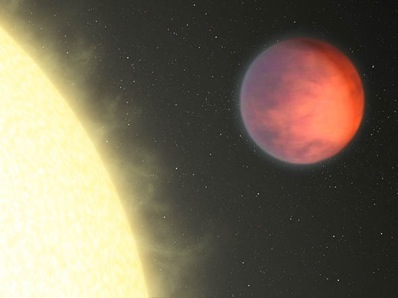
Exoplanet's hot spot
in wrong place
DR EMILY BALDWIN
ASTRONOMY NOW
Posted: 20 October 2010


Observations of a distant hot-jupiter by NASA's Spitzer Space Telescope reveal a hot spot in the planet's atmosphere in an unexpected location.
Andromedae b orbits tightly around its star with one face permanently locked towards the Sun. The hottest part of a tidally locked planet's atmosphere is usually offset by a few degrees as a response to winds arising from the temperature difference blowing hot air to cooler regions, but for this gas giant, the hot spot is offset by a staggering 80 degrees. That is, the hot region is essentially on the 'side' of the planet instead of in the direct line of sight of the solar heating.

This graph shows how the hot spot was located, by measuring the total infrared light of the planet and star – when the hot spot faces Earth, the total brightness of the system increases. The black line shows the response if the hot spot was located in the middle of the Sun-facing side of the planet. The light curve (yellow line) was observed, offset by 80 degrees. Image: NASA/JPL-Caltech/I.J.J Crossfield (UCLA).
“We really didn’t expect to find a hot spot with such a large offset,” says Ian Crossfield, lead author of research soon to be published in the Astrophysical Journal. “It’s clear that we understand even less about the atmospheric energetics of hot Jupiters than we thought we did.”
One explanation is extremely fast winds – perhaps even supersonic winds – that distort the temperature patterns of the planet's atmosphere by triggering shock waves in the atmosphere. Another suggestion is that magnetic field interactions between the star and planet could play a role.

Artist impression of the hottest part of Andromedae b curiously located towards the 'dark' side of the planet. Image: JPL.
“This is a very unexpected result,” adds Spitzer project scientist Michael Werner. “Spitzer is showing us that we are a long way from understanding these alien worlds.”
Andromedae b speeds round its host star once every 4.6 days, and was discovered via the radial velocity technique – the tell-tale wobble it induces in the star's motion as it moves towards and away from the observer.
|



